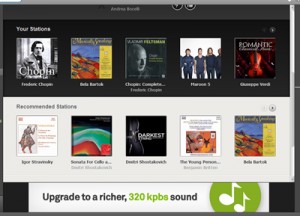 My colleague Paul Riismandel has been warming up to the Spotify music service, of late, and gave it a pretty decent review in a recent post. Paul also mentioned to me that Spotify has been advertising itself as a “goldmine” for a wide variety of formats, including classical music. This aroused my attention, since I am an avid classical music lover.
My colleague Paul Riismandel has been warming up to the Spotify music service, of late, and gave it a pretty decent review in a recent post. Paul also mentioned to me that Spotify has been advertising itself as a “goldmine” for a wide variety of formats, including classical music. This aroused my attention, since I am an avid classical music lover.
Alas, after a week of listening to Spotify’s classical “radio” feature, I have to report that I find it a pretty shallow experience. This is not to say that you’ll come to the same conclusion. Full disclosure: I’m a snob when it comes to this stuff, and prefer the adventurous classical pay off that you get from the user run turntable.fm room Classical of Any Kind, or the classical shows on public radio stations like KALW-FM in San Francisco.
The good news, however, is that an enthusiast can curate Spotify from the outside—that is, develop external interfaces that allow a listener to foreground the really great stuff that a Spotify beginner would have a tough time finding. We’ll get to that happy ending later in this article.
Two ways
You can listen to Spotify conventionally in at least two different ways: you can search for individual tunes and add them to your queue or playlist, or you can fire up your own “radio” channel. The latter option is easy. Just go to “radio,” click “create new station,” search for a composer or a performer, and Spotify starts choosing pieces for you. This isn’t all that different from what you get over at Pandora or Clear Channel’s iHeartRadio.
The problem with these channels is that they stray rather quickly from my desired destinations. When I started a “Chopin” station, tons of non-Chopin music started coming in my direction: Mozart, Beethoven, Vivaldi, Pachelbel, followed by an annoying trail of easy listening piano meditations (e.g., Yiruma). I found that the “thumbs up/down” option didn’t prevent this from continuing. I also noticed that a lot of the Chopin selections I heard came from general classical music anthologies, rather than from high end performance albums.
This wasn’t so bad. But when just a little while ago I went to my “Maria Callas” station, I got Glenn Gould playing the Goldberg Variations (WTF??). This was followed by a rendition of Rachmaninoff’s “Vocalise” which came from an album titled “100 Best Adagio Voices,” which identified the soprano as Natalie Dessay.
To be fair, I did better with the Callas radio channel when I first launched it last week. I got some really nice selections from the opera for which she is best remembered, Tosca. Soon, however, the station started queuing up other sopranos, among them Barbara Bonney and Cecilia Bartoli. Again, this wasn’t the end of the world. But next came a pop selection from Julio Iglesias (?!?), and then an advertisement.
Paul mentioned that he did not find the ads any more annoying than Pandora’s. At the deserved risk of being accused of snobbishness, I think it’s a tougher call with the classical genre. I’m sure that the spot I heard for the best of Rob Zombie wouldn’t sound that unpleasant on a Heavy Metal channel. But it was very jarring after listening to a string of Chopin pieces and classical soprano arias. Context means everything here.
The larger problem is the dubious algorithmic assumption that if you choose a composer who wrote his pieces in, say, 1820, you’ll probably want to hear other composers who wrote around that time (give or take 50 years). Or, if you choose some classical performer, you’ll want to hear other performers whom Spotify thinks are similar. Speaking personally, that’s not what I’m looking for. And I don’t want to spend my time clicking thumbs up and down buttons in the hope that Spotify will eventually get it.
On the other hand, I want somebody to get it. After all, that’s what radio is about: a stream of interesting sounds produced by somebody else who gets what you really want.
A third way
Persnickety, I know, but this brings us to what is probably the best way to appreciate Chopin and Callas on Spotify—have someone else provide a guided tour for you. The tour guide in question is ulyssestone, who lives in Beijing and runs a web site called Spotify Classical Playlists. You want Bach Cantatas? Never mind starting your own Bach Cantata channel. Just log into Spotify, and then go to his. ulyssestone has everything queued up from Josquin des Prez to Karlheinz Stockhausen.
It isn’t technically hard to do this. For example, if you’d like to post a link to Faure’s Nocturne for Piano Number 5 in B flat major, just search for the piece, then right click to access the embed code.
<iframe src=”https://embed.spotify.com/?uri=spotify:track:5T9s1gqvJOpQ2VSsqJ98TY” width=”300″ height=”380″ frameborder=”0″ allowtransparency=”true”></iframe>
Which looks like the image below.
You can also embed entire albums and your playlists this way. Here is my Faure Nocturne playlist.
The real work is in finding this wonderful stuff and putting it on the web with lots of context and links as ulyssestone has. To recap, if you don’t mind a bit of awkward chaos and blundering, Spotify classical “radio” will probably work for you. But creating your own Spotify classical radio stations is a lot more appealing, I think, than relying on Spotify’s strange “radio” algorithms. Or, even better, find somebody else’s Spotify embedding playlist masterpiece, and listen to theirs (and don’t forget to say “thanks”!).
PS: I’m hoping that my friend Bob Mason will have a review of the Alexander Street Library up on these pages soon.


